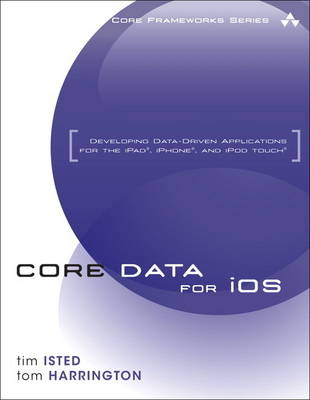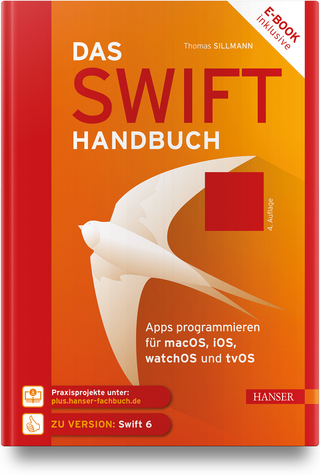
Core Data for iOS
Addison-Wesley Educational Publishers Inc (Verlag)
978-0-321-67042-7 (ISBN)
- Titel ist leider vergriffen;
keine Neuauflage - Artikel merken
• Understanding Core Data’s features, classes, and interactions
• Using Core Data in MVC-based iOS app development
• Mapping relational data to object models, and building them with Xcode 4’s Data Modeler
• Working with managed objects and using UITableView to display them
• Creating predicates to match numbers, data, and objects
• Maintaining compatibility across versions of an app’s data model
• Tracking managed object contexts across view controllers
• Using Core Data’s automatic Undo functionality
• Integrating abstract entities, entity inheritance, and multiple view controllers into a complete app
• Optimizing for iOS devices’ tight memory limits
• Diagnosing and fixing common Core Data problems
Introducing Addison-Wesley’s new Core Frameworks Series, written for experienced iOS developers by world-class Mac and iOS developers, these are the first comprehensive, code-rich reference guides to Apple’s Core Frameworks.
Tim Isted has been writing software for Macintosh computers since 1995. He also builds web applications using Rails, PHP, and .NET and has been known to develop for Windows machines too. Also a professional musician and singing teacher, he tries to divide his time fairly equally between conducting, accompanying, teaching, and writing software. Previous musings on Core Data for desktop development can be found on his blog at www.timisted.net, and he is also co-organizer of NSConference, a new Mac developer conference taking place in both Europe and the USA. Tom Harrington switched from writing software for embedded systems and Linux to Mac OS X in 2002 when he started Atomic Bird, LLC. After six years of developing highly regarded Mac software he moved to iPhone in 2008. He develops iOS software on a contract basis for a variety of clients. Tom also organizes iOS developer events in Colorado. When not writing software he can often be found on his mountain bike. His website is www.atomicbird.com.
Preface ix
Part I Introduction
1 An Overview of Core Data on iOS Devices 3
A Little History 3
The Birth of Core Data 4
Why Use Core Data on iOS? 4
Relationship Management 4
Managed Objects and Data Validation 5
Undo and State Management 5
Core Data iOS and Desktop Differences 5
The Fetched Results Controller 6
Core Data Case Studies 6
MoneyWell for iPhone 6
Calcuccino 7
Associated Press 8
2 A Core Data Primer 9
Persisting Objects to Disk 9
The Core Data Approach 10
Entities and Managed Objects 10
Relationships 11
Managed Object Contexts 12
Fetching Objects 14
Faulting and Uniquing 14
Persistent Stores and Persistent Store Coordinators 15
Examining the Xcode Core Data Templates 15
The Navigation-Based Project Template 16
The Data Modeler 16
Setting up the Core Data Stack 17
Running the Application 20
A Quick Look at the RootViewController Code 20
Summary 21
3 Modeling Your Data 23
Managed Objects and Entities 23
Dividing Your Data into Entities 24
Core Data in Model-Object Terms 24
Data Normalization 25
Storing Binary Data 27
Working with Xcode’s Data Modeler 28
Creating Entities 29
Creating Properties 31
Creating Relationships 35
Summary 37
Part II Working with Core Data
4 Basic Storing and Fetching 41
Creating New Managed Objects 41
Saving the Context 42
Fetching Saved Managed Objects 44
Deleting Managed Objects 45
Working with Table Views 46
The Random Dates Application Project 47
The Random Dates Data Model 48
Basic RootViewController Behavior 49
Fetching the Random Date Objects 51
Displaying the RandomDate Objects 52
Deleting the RandomDate Objects 54
Custom Managed Object Sub-Classes 54
Creating and Setting a Custom Class for a Managed Object 56
Summary 60
5 Using NSFetchedResultsController 61
Introducing NSFetchedResultsController 62
Creating an NSFetchedResultsController 62
Supplying Information to Table Views 64
The Number of Sections and Rows 65
Returning the Cell for an Index Path 67
Returning Information about Sections 68
Handling Underlying Data Changes 69
Caching Information 72
Using an NSFetchedResultsController in the Random Dates Application 73
Subclassing NSFetchedResultsController 80
Summary 85
6 Working with Managed Objects 87
Basic Managed Object Subclass Files 87
Creating the Random People Project 88
Managed Object Class Interfaces 89
Managed Object Class Implementations 90
Configuring the Random People Application 93
Displaying the Information 95
Data Validation 99
Validating Individual Properties 99
Validation Based on Other Properties 101
Validation Prior to Deletion 104
Fixing the Random People Application 105
Working with Transient Attributes 105
Modifying the Data Model 106
Adding to the AWPerson Interface and Implementation 106
Adding a Getter Method for the Transient Property 108
Adding a Setter Method for the Transient Property 110
Using the UIColor Property 111
Working with Transformable Attributes 113
The Managed Object Lifecycle 114
Initializing Non-persistent Properties 114
Summary 116
7 Working with Predicates 117
Predicate Basics 117
Creating Predicates Using Format Strings 118
Predicate Variables 120
Predicate Comparison Operators 122
Key Paths 123
Comparing Strings 124
Compound Predicates 126
NSCompoundPredicate 128
Sets and Relationships 129
Examining SQL Queries 130
Adding a Search Display Controller 130
Setting a Fetch Predicate 132
Modifying the Search Predicate 136
Adding a Search Scope Bar Filter 139
Summary 141
8 Migration and Versioning 143
The Migration Problem 143
Changing the Data Model 144
Multiple Data Model Versions and Lightweight Migration 145
Creating Data Model Versions 145
Enabling Lightweight Migration 146
Renaming Entities and Attributes 148
Supplying Renaming Identifiers 150
Keeping Track of Multiple Versions 151
Mapping Models 152
Custom Entity Migration Policies 156
Summary 160
9 Working with Multiple View Controllers and Undo 163
Editing Managed Objects 163
Keeping Track of the Managed Object to Edit 164
Updating a Managed Object’s Properties 168
Validating Managed Objects 171
Working with Undo 174
Multiple Managed Object Contexts 175
Merging Changes from Other Managed Object Contexts 178
Changing Managed Object Values Whenever the Control Values
Change 179
Resetting a Managed Object Context 181
Using the Editor Controller to Add New Objects 182
Summary 183
Part III Building a Simple Core Data Application
10 Sample Application: Note Collector 187
The Note Collector Application 187
Creating the Note Collector Project 188
The Application Data Model 188
Modeling an Abstract Entity 189
Modeling Sub-entities 189
Creating Managed Object Class Files 190
Configuring the RootViewController 192
Displaying the Contents of a Collection 195
Keeping Track of the Collection to be Displayed 196
Examining the Contents of a Raw Data File 200
Setting and Editing an Item Name 202
Creating the New View Controller 203
Displaying and Editing Notes 210
Supplying a Pre-Populated Data Store 217
Working with a Data Store in the Application Bundle 217
Summary 219
Part IV Optimizing and Troubleshooting
11 Optimizing for iOS Performance and Memory Requirements 223
Performance, Optimization, and Speed 224
Data Store Types 224
Binary and Memory Data Stores 225
SQLite Data Store 225
Monitoring SQLite Stores 225
Optimizing Fetching 230
Setting Fetch Limits 230
Optimizing Predicates 231
Pre-Fetching Relationships 233
Pre-Fetching Any Object 234
Pre-Loading Property Values 235
NSFetchedResultsController and Sections 235
Managing Faulting 235
“Safe” Fault-Free Methods 236
Preventing Property Loading 237
Batch Faulting 237
Re-faulting Objects 237
Managing BLOBs 238
Putting BLOBs in the Entity That Uses Them 239
Putting BLOBs in a Separate Entity 240
Putting BLOBs in External Files 242
Monitoring Core Data with Instruments 245
When Not to Use Core Data 248
Other Memory Management Tips 248
Don’t Use an Undo Manager If You Don’t Need It 249
Resetting the Managed Object Context 249
Summary 249
12 Troubleshooting Core Data 251
Your First Core Data Error 251
The Missing Model 254
Classes Not Found? 255
Core Data Threading Issues 257
Basics of Core Data Multithreading 257
Coordinating Data Between Threads 258
When Threads Collide, or Handling Data Conflicts 260
Danger! Temporary ID! 264
Problems Using Managed Objects 265
Crashing When Setting Property Values 265
If Custom Accessor Methods Aren’t Called 266
Managed Object Invalidated 267
Faults That Can’t Be Fulfilled 268
Problems Fetching Objects 269
Trouble Sorting Data During Fetches 269
Fetch Results Not Showing Recent Changes 270
Summary 270
Index 271
| Erscheint lt. Verlag | 9.6.2011 |
|---|---|
| Verlagsort | New Jersey |
| Sprache | englisch |
| Maße | 236 x 181 mm |
| Gewicht | 482 g |
| Themenwelt | Mathematik / Informatik ► Informatik ► Betriebssysteme / Server |
| Informatik ► Programmiersprachen / -werkzeuge ► Mac / Cocoa Programmierung | |
| Informatik ► Software Entwicklung ► Mobile- / App-Entwicklung | |
| Informatik ► Weitere Themen ► Smartphones / Tablets | |
| ISBN-10 | 0-321-67042-6 / 0321670426 |
| ISBN-13 | 978-0-321-67042-7 / 9780321670427 |
| Zustand | Neuware |
| Informationen gemäß Produktsicherheitsverordnung (GPSR) | |
| Haben Sie eine Frage zum Produkt? |
aus dem Bereich

